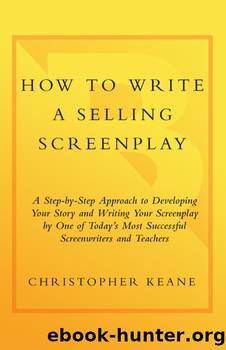How to Write a Selling Screenplay by Christopher Keane

Author:Christopher Keane [Keane, Christopher]
Language: eng
Format: epub
ISBN: 978-0-307-56774-1
Publisher: Crown/Archetype
Published: 1998-01-15T00:00:00+00:00
I have rewrittenâoften several timesâevery word I have ever published. My pencils outlast their erasers.
Vladimir Nabokov, novelist and author of Lolita
âWriting is rewriting.â
âThe first draft is labor, all the rest are management.â
These old adages seem more important today than ever before. Yet there are those who, by the completion of the first draft, feel they have it all in hand. A pinch here, a tuck there, and the thing is done, ready to be embraced by the world. When word comes back that the script is less than perfect, in fact, far from perfect, the writer feels this great hole in his gut, as if he has committed the greatest sin of allâdeceit of self. âHow could I have been so stupid as to not have seen these flaws?â he might ask. Or, in the case of the angry, defensive writer, âHow can they be so stupid as to not see the real genius of this masterpiece?â Then everything settles down and the writer begins to revise, barreling forward into the rewrite.
Where do you start? What do you look for?
I finish the first draft, and then set it down for a week or two to get a better perspective. During this time I give it to people who can read screenplays and offer sound advice. Once I get my readersâ suggestions, I head back into the battle, armed with their advice and the two weeks of my own thoughts and note-taking. Then I bring out the 3#5 index cards and chart a rewrite course through the story.
I begin with character. I take aim at the main characters and draw a line from the beginning to the end of the screenplay to see what has occurred with each. This is the character arc: a scene-by-scene delineation of how each central character progresses through the story.
In the first draft, you already have the story laid out, at least the fundamentals of it. Itâs the characters who have eluded you. You have spent a lot of time laying down the story track, and the characters have suffered. Fine, no problem. Thatâs the way it should happen.
The second step goes beyond character into what all stories are ultimately about: relationships. Trace the arc of the central relationships in your story. On the cards, write the essential elements of the scenes in which the main characters meet and what happens to them. Tack them to the wall and look at the progression. Youâll discover fascinating things. The cards will give you a clear line from beginning to end. Once you see the progression, youâll be able to pinch here and tuck there and begin to build the relationships into the rewrite. You must take a very close look at these relationship arcs. Theyâre the key to a successful screenplay.
How does the Romeo and Juliet relationship move from one point to the next? How do Thelma and Louise get along together so that, at the end, they can both agree that going over the cliff together is the only answer?
Some writers make two lists.
Download
This site does not store any files on its server. We only index and link to content provided by other sites. Please contact the content providers to delete copyright contents if any and email us, we'll remove relevant links or contents immediately.
Kathy Andrews Collection by Kathy Andrews(11324)
The remains of the day by Kazuo Ishiguro(8395)
Paper Towns by Green John(4798)
Spare by Prince Harry The Duke of Sussex(4788)
Industrial Automation from Scratch: A hands-on guide to using sensors, actuators, PLCs, HMIs, and SCADA to automate industrial processes by Olushola Akande(4600)
The Body: A Guide for Occupants by Bill Bryson(4583)
Be in a Treehouse by Pete Nelson(3648)
Machine Learning at Scale with H2O by Gregory Keys | David Whiting(3624)
Harry Potter and the Goblet Of Fire by J.K. Rowling(3609)
Never by Ken Follett(3526)
Goodbye Paradise(3446)
The Remains of the Day by Kazuo Ishiguro(3138)
Into Thin Air by Jon Krakauer(3131)
The Cellar by Natasha Preston(3077)
The Genius of Japanese Carpentry by Azby Brown(3038)
Fairy Tale by Stephen King(2948)
120 Days of Sodom by Marquis de Sade(2939)
Drawing Shortcuts: Developing Quick Drawing Skills Using Today's Technology by Leggitt Jim(2939)
The Man Who Died Twice by Richard Osman(2807)
